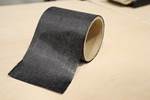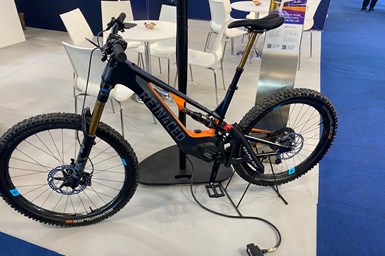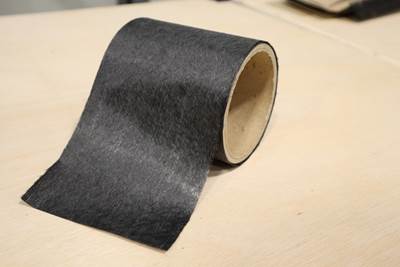Composites end markets: Sports and recreation (2025)
The use of composite materials in high-performance sporting goods continues to grow, with new advancements including thermoplastic and sustainability-focused materials and automated processes.
The market for composites in sporting goods and recreation applications is vast, including carbon fiber composite plates in athletic shoes (top left), bicycle frames and other bike components (top right), panels and roofs for recreational vehicles (bottom right), and snow and water skis (bottom left). Source (clockwise from top left) | Carbitex Inc., CW, Knaus Tabbert, John Yan
Composite materials have risen above other high-performance materials like titanium in many elite sporting goods applications for their high strength-to-weight ratio, vibration damping ability, lack of corrosion issues and ability to be tailored in the design and manufacturing process to meet very specific or custom requirements.
According to the most recent “Composites in Sporting Goods Market” report from market research firm Lucintel (Irving, Texas, U.S.) published in July 2024, the future of composites in the global sporting goods market “looks promising,” expected to reach an estimated $1.5 billion by 2030 with a CAGR of 10% from 2023-2030. Light weight and high performance are cited as major growth drivers.
Lucintel projects that golf clubs and shafts will remain the largest application segment over the next several years, with opportunities for growth in other applications including skis and snowboards, bicycle parts, rackets, hockey sticks and fishing rods. Carbon fiber is the most used reinforcement for sporting goods, with the best strength-to-weight ratio for high-level performance in elite sports.
New applications
In addition to growth in these conventional markets, over the past year, CompositesWorld (CW) has also covered the adoption of composites into new applications, as well as trends toward more sustainability-focused materials or manufacturing technologies.
For example, the JEC World 2024 trade (Paris, France, March 2024), which was held a few months before the 2024 Summer Olympics in Paris, provided an opportunity for manufacturers and suppliers to display their latest materials and process advancements in this field, including new uses of natural fiber composites, thermoplastics and more.
Ahead of the 2024 Paris Olympics, a variety of composite sporting goods were on display at the JEC World 2024 trade show. Source | CW
Among the parts on display were watersports manufacturer Cobra International’s (Chonburi, Thailand) carbon fiber composite surfboard. “These are gaining in popularity among athletes,” notse CEO Danu Chotikapanich, for their ability to reach higher speeds and better springback compared to fiberglass boards. Also highlighted were glass/carbon fiber composite IQFoil boards used in the Olympics. In addition, Mel Composites (Barcelona, Spain), a first-time exhibitor at the show and a distributor of custom foam, epoxy resins and consumables used in vacuum infusion, showcased padel rackets manufactured by customer Karbondesign (Barcelona). Padel is a fast-growing sport that is a mix between tennis and squash.
Beyond JEC World and the world of sporting goods, one example of a new sports equipment application for composites is modular, multi-material, multi-sport tracks manufactured by startup X-Track (Sherbrooke, Quebec, Canada). Developed initially as a safer, more durable, easier-to-transport and -install alternative to traditional outdoor dirt tracks often used for bike and motocross racing, X-Track modules comprise an aluminum frame topped with a curved composite sandwich panel produced by partner bespline (Sherbrooke) with integrated rubber surface material.
X-Track’s composites-intensive track modules can be used for indoor or outdoor racing events in a variety of sports, designed for easy transport and assembly as well as durability. Source | X-Track
The composite panels are manufactured using adaptive molds, preshaped foam core and vacuum infusion. In a recent CW article, X-Track’s co-founder explains that the complex shapes needed for race track modules, and the durability required to withstand repeated impacts from race vehicles, wouldn’t be possible without composite materials.
A variety of advancements in sports and recreation applications have also been sustainability-focused, featuring recycled materials and/or bio-based fibers or resins. For example, watersports equipment manufacturer HO Sports (Snoqualmie, Wash., U.S.) launched its Sabre water ski developed in partnership with biotechnology company Checkerspot (Alameda, Calif., U.S.), featuring a bio-based foam core designed specifically for water skis. Developed through Checkerspot’s Wing Platform, the foam is custom-formulated from algae-derived biomaterials to meet desired performance properties with less reliance on fossil fuels.
In 2025, all Melker kayak models will feature Bcomp flax reinforcement fabrics, Amorim cork and plant-based resins and gelcoats from Sicomin. Source | Melkor of Sweden
Another example recently covered by CW is the Värmdö sea kayak from Melker of Sweden (Solna), launched in late 2024. It incorporates ampliTex flax fibers from Bcomp Ltd. (Fribourg, Switzerland), GreenPoxy resin and GreenCoat gelcoats from Sicomin (Chateuneuf les Martigues, France) and a cork core. The kayak won Product of the Year 2025 in the Sea Kayaking category at the Paddle Sports Show in Strasbourg, France. Also incorporating Sicomin’s GreenPoxy resin, Notox Surfboards (Anglet, France) has unveiled a line of custom-built, tow-in surfboards made from GreenPoxy 56, upcycled aerospace carbon fiber fabrics, woven flax fiber fabric from Libeco (Meulebeke, Belgium) and agave core.
Similarly, Head Sports GmbH (Kennelbach, Austria) also recently announced that it is developing prototype tennis rackets and pickleball paddles made with bio-circular carbon fiber from Toray Carbon Fibers Europe (Paris, France).
Within the larger sports and recreation category, bicycles, athletic shoes and recreational vehicles have recently grabbed a lot of headlines. While not an exhaustive list, several new developments covered by CW are outlined below.
Bicycles: Developments toward thermoplastics, automation
Carbon fiber composite bicycle frames, particularly for high-end sports bikes, have become increasingly popular in recent years as the ultimate lightweight material option with high strength, natural vibration damping and no corrosion issues compared to metal bike frames.
According to Lucintel in its July 2024 global bicycle market report, the global bicycle market size was $47.8 billion, expected to grow about 4% annually to $62 billion by 2030. Lucintel cites “rising fuel prices, government programs to build bicycle paths and roads, increasing health concerns/fitness consciousness, growing environmental awareness and increasing traffic congestion” as top drivers for this growth, with Europe leading demand and e-bicycles as the market segment projected for the highest growth.
Market research firm Technavio (London, U.K.), looking specifically at the high-end bicycle market (including those made with carbon fiber composites or titanium), as of December 2024, projects $6.5 billion in growth between 2024 and 2029 at a CAGR of 7.5%.
According to these cited reports and CW’s 2022 feature on carbon fiber-reinforced polymer (CFRP) bike frame manufacture, a majority of this fabrication occurs in Asia, producing up to 99% of CFRP bike frames globally. Most of these are produced via hand layup using carbon fiber/epoxy prepreg.
However, many companies in North America and Europe have reported goals in the last few years of becoming more competitive in this space, including adoption of automated processes and thermoplastic composite (TPC) materials.
Canadian bike manufacturer Argon 18 currently makes road bikes based on thermoset composites, but sees a place for thermoplastics to grow in the future. This TPC seat post demonstrator showcased design and manufacturing possibilities. Source | CDCQ, LxSim and Argon 18
For example, as reported by CW’s Ginger Gardiner, Argon 18, a high-quality bike manufacturer in Montreal, Canada, worked with the Quebec Composites Development Centre (CDCQ, Saint-Jerome, Canada) and engineering simulation specialist LxSim (Bromont, Canada), as well as composites automation company Addcomp (Sherbrooke, Canada) to evaluate six different TPC materials. It developed an optimized layup for 2D blanks which were made using automated fiber placement (AFP), shaped onto a mandrel and then compression molded using a bladder-based process to produce and test two of these materials in a bike seat post demonstrator.
Seeing success in this first demonstrator part, the company is working to refine the process and push the technology further. As Vincent Lemay, VP of R&D at Argon 18, summarizes: “We do see a big shift coming in the cycling industry. Everything is geared right now to use thermoset composites, but we’ve seen companies start to use TPC in mountain bikes and Rein4ced is also working with it in road bikes. But there are also significant challenges in developing the manufacturing processes. You can’t just go and buy the equipment off-the-shelf. It’s not there yet. So, we need to develop the recipe and the equipment according to what we need, and that’s why this type of project was so valuable.
As demonstrated by this bicycle on display at JEC World 2024, Dieffenbacher and Rein4ced have collaborated on a fully automated bike frame production line, which will be expanded to other composite products. Source | CW
As Lemay mentioned, in 2024 composites manufacturer Rein4ced (Leuven, Belguim) and equipment supplier Dieffenbacher (Eppingen, Germany) teamed up to propel large-scale production of carbon fiber-reinforced thermoplastic (CFRTP) road bicycle frames. A serial production line was built to produce frames from unidirectional TPC tapes. The line, built at Rein4ced’s facility, is based on Dieffenbacher’s automated Tailored Blank Line, which lays up tapes and consolidates them into blanks, followed by a thermoforming line containing an oven and Fiberpress, which forms the blanks into their final part shapes. As of early 2024, Rein4ced said it was planning to use its Leuven facility as a pilot plant for production.
Athletic shoes: Increasing applications, sustainable materials
Carbon fiber composites can also be incorporated into elite athletic and protective gear, most notably in the form of plates in the midsoles of elite running shoes. These stiff structures serve as a sort of springboard for the foot to increase propulsion and speed and to improve running efficiency by optimizing energy return. The “super shoes” phenomenon began with Nike’s Vaporfly 4%, popularized when the top three male finishers in the 2016 Summer Olympics marathon wore them. Since then, most running shoe companies have released running shoes with carbon fiber plates. (Note: World Athletics has since imposed some limitations on their use in competition, to mitigate risks of unfair advantages.)
Over the past several years, Carbitex Inc. (Kennewick, Wash., U.S.) has developed a line of flexible carbon fiber/thermoplastic plates for use as soles in athletic shoes. These plates, designed to flex with the human foot but add strength and stiffness in needed areas, have been launched to the market with various brands in shoes for soccer, golf, running, watersports, snowsports and more. In October 2024, the company announced it had secured new funding and is projecting a fivefold sales growth in 2025.
Shoe plates are also one of several focus areas for Arris Composites (Berkeley, Calif., U.S.), a company founded in 2017 commercializing its Additive Molding technology that combines automated preforming of thermoplastic prepregs followed by consolidation (for more, see CW brand VP Jeff Sloan’s plant tour of Arris’ facility).
Arris Composites’ Additive Molding process is used for a variety of products ranging from consumer to aerospace markets, including continuous carbon fiber composite plates used in elite running shoes and under evaluation for military applications. Source | Arris Composites
In early 2024, Brooks Running launched its Hyperion Elite 4 running shoe featuring carbon fiber composite plates manufactured by Arris. Also in 2024, Arris announced that its continuous carbon fiber composite plates are also being evaluated in a study by the U.S. Army for use in the insoles of military shoes, as well as its first direct-to-consumer brand Aurrora by Arris (AXA) to sell products including carbon fiber shoe plates online and at pop-up events.
There are also several companies working on new developments for the manufacture of composite shoe components made with recycled materials. For example, recycling company Thermolysis Co. Ltd. (Taichung City, Taiwan) has released a study proving that its injection-moldable pellets made from 20% short recycled carbon fiber (rCF) and polycarbonate and 30% rCF with polyphthalamide meet or exceed flexural and tensile strength of virgin carbon fiber. The company has launched a line of bicycle water bottle holders made with this material, and says it is working toward rCF composite shoe midsoles.
In early 2024, global energy company Acciona Energía (Alcobendas, Spain) and El Ganso (Madrid, Spain) launched a limited edition sneaker featuring fiberglass and epoxy from recycled wind turbine blades directly incorporated into the rubber in the shoes’ soles, demonstrating the potential of shoes as an option for wind blade recycling.
Recreational vehicles and beyond
Beyond sporting goods, fiberglass composite materials are also used in many other types of consumer products and recreational equipment, including inground swimming pools and spas (with composites reportedly making up about 12-15% of the U.S. market, which is growing), as well as the wall panels, roofs and floors of recreational vehicles (RV).
The RV Industry Association’s (RVIA, Reston, Va., and Elkhart, Ind., U.S.) Winter 2024 quarterly forecast, prepared by ITR Economics for the RVIA and released in December 2024, projects 2024 RV shipments to reach 324,100 units, and then to increase in 2025 up to the mid-300,000 unit range.
“Wholesale shipments are edging up slightly over last year’s total in the face of stubborn interest rates and stretched consumer finances,” says RVIA president and CEO Craig Kirby. “The market is poised for additional growth next year with dealer inventories at healthy levels, continued strong consumer interest in RV ownership, and interest rates that are expected to ease.”
Fiberglass composites are common in RV components for their light weight and durability, though some carbon fiber composite designs have also been developed, and recent innovations have included moves toward bio-based or styrene-free materials.
Representing a new end market for Greenboats, the Greenlander Sherpa was launched at JEC World 2024 and the Caravan Salon 2024. Source | Greenboats
For example, the flax fiber composite-intensive Greenlander Sherpa RV was launched in 2024. Developed by Greenboats GmbH (Bremen, Germany), a company founded originally to manufacture boats from natural fiber composites and which has since expanded into the manufacture of flax fiber composite panels, custom components and now RVs.
The Greenlander Sherpa is a premium camper developed with design partner Langefreunde Design Studio (Schwerin, Germany) and manufacturing partner Borco Höhns GmbH (Rotenburg, Germany).
All of the exterior structures for the camper are constructed from Greenboats’ flax fiber composite sandwich panels. The company built the first few iterations of the RV, which was presented to the composites industry at JEC World 2024, and to the RV industry at the Caravan Salon 2024 in Düsseldorf, Germany, at its own facility. Ultimately, partner Borco Höhns will build the production vehicles using panels supplied by Greenboats.
As the company scales up sales of its product, one goal is for customers to be able to return Greenlander Sherpa vehicles back to Greenboats at their end of life, and for the company to reuse the composite panels to build new campers or other applications.
Another materials innovation reported recently is the development of a fiberglass composite camper roof made from styrene-free resin and gelcoat. Produced by plastic fabrication company Indupol (Arendonk, Belgium), resin supplier AOC (Schaffhausen, Switzerland) and composite solutions company Büfa (Rastede, Germany) for customer Knaus Tabbert, the resin transfer molded (RTM) roof was designed to meet new European legislation changes requiring very low levels of volatiles.
To meet these new requirements, Indupol used a styrene-free gelcoat and RTM formulation combination for making components with close-to-zero emissions. AOC proposed a novel styrene-free Beyone 215-A-01 formulation, enabling a smooth injection process, which Büfa supplied to Indupol; both AOC and Büfa have spent many years developing these products, and report that they are expecting the technologies to be broadly commercialized in the near future.
Related Content
Composites manufacturing for general aviation aircraft
General aviation, certified and experimental, has increasingly embraced composites over the decades, a path further driven by leveraged innovation in materials and processes and the evolving AAM market.
Read MoreNatural fiber composites: Growing to fit sustainability needs
Led by global and industry-wide sustainability goals, commercial interest in flax and hemp fiber-reinforced composites grows into higher-performance, higher-volume applications.
Read MoreIndustrializing additive manufacturing in the defense/aerospace sector
GA-ASI demonstrates a path forward for the use of additive technologies for composite tooling, flight-qualified parts.
Read MoreCW Top Shops 2023: Honoring global top-performing facilities
CW congratulates the 2023 CW Top Shops honorees and composites fabricators whose leaders cite team expansion, focus on Industry 4.0 and adaptation to emerging markets among this year’s top achievements.
Read MoreRead Next
VCARB, Holy Technologies demonstrate composites recyclability potential for Formula 1
Fully recyclable, race-ready carbon fiber/epoxy mirror housing component using Holy’s IPT technology highlights track-proven durability, paves way for future motorsport components.
Read MoreDemonstrator project targets circularity solutions in carbon fiber composite sports equipment
The Carbon Fibre Circular Alliance (CFCA) brought together OEMs and technical partners to reclaim short carbon fibers from end-of-life sports equipment, realign into continuous prepreg tapes and remanufacture into new equipment.
Read MoreComposites end markets: Boatbuilding and marine (2025)
As 2023-2024 consumer demand slows, boat and marine vessel manufacturers continue to focus on decarbonization and new technologies using composites.
Read More.jpg;width=70;height=70;mode=crop)
























